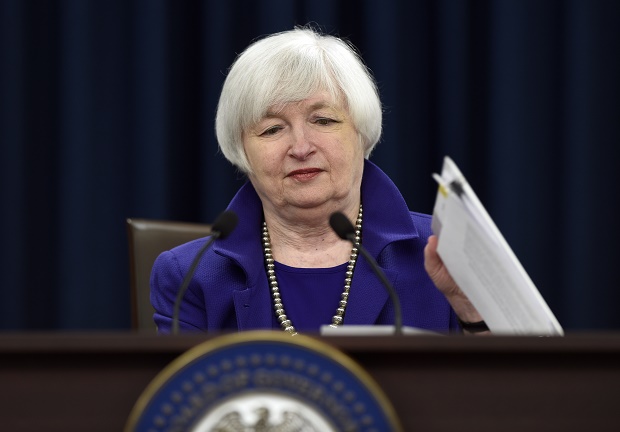
Federal Reserve Chair Janet Yellen closes her notebook after holding a news conference in Washington, Wednesday, Dec. 16, 2015, following an announcement that the Federal Reserve raised its key interest rate by quarter-point, heralding higher lending rates in an economy much sturdier than the one the Fed helped rescue in 2008. AP Photo
WASHINGTON, United States—After the riskiest move of her career, US Federal Reserve Chair Janet Yellen has committed to a balancing act to keep her promise of gradual future interest rate increases.
READ: Fed announces historic rate increase, first since 2006
The slight quarter-point increase decided Wednesday that ended seven years of the near-zero benchmark federal funds rate had been telegraphed well in advance by the US central bank and was met with equanimity by the markets.
But the question that now haunts financial players is “how far, how fast” rates will rise, said economist Edwin Truman at the Peterson Institute for International Economics.
READ: World watches with US Fed expected to raise rate
“‘Gradual’ is now the key word for Fed statements going forward,” said his colleague Angel Ubide, who sees the pace at 100 basis points a year, which would bring the range of the Fed funds rate to 1.25-1.50 percent by the end of 2016.
A number of analysts see the next Fed hike in March.
In its statement, the policy-setting Federal Open Market Committee (FOMC) emphasized several times that the trajectory of rate rises from the historic low would be “gradual” and dependent on economic data, while officials would continue to monitor tepid inflation and take into account “domestic and international developments.”
For the Fed, the policy path is narrow. Lifting rates too rapidly risks undermining the slow, moderate economic recovery from the Great Recession. Allowing them to languish at lows could spark a surge in inflation that could force the central bank to act aggressively.
In its latest projections, the Fed estimated the world’s largest economy would grow 2.1 percent this year, slowing from a 2.4 percent expansion in 2014.
“What we would like to avoid is a situation where we have waited so long that we are forced to tighten policy abruptly, which risks aborting what I would like to see as a very long-running and sustainable expansion,” Yellen said in a post-meeting news conference.
Inflation currently is at a weak 0.2 percent annual rate, weighed down by falling oil prices and a stronger dollar that makes US imports less expensive. The Fed has insisted it remains confident that inflation will move towards its 2.0 percent objective.
Room to move
By exiting the zero-bound rate policy, the Fed is giving itself room to move. If the economy slows, it can lower rates again.
“One shouldn’t lose sight of the fact that the FOMC didn’t raise rates on Wednesday so much out of economic growth necessity as it did for its own peace of mind,” said Patrick O’Hare at Briefing.com.
“Dovish” or “hawkish,” the future path of rates is the object of multiple interpretations.
Take the FOMC’s famous chart known as the “dot plot,” which showed the median estimate for rates at the end of 2016 at 1.4 percent.
That would seem to indicate a not-so-slow pace of nearly five quarter-point increases in the next year.
But the chart also showed that, compared with the dots in September, the arc of hikes is lower.
Three months ago, the FOMC’s “central tendency” estimate was for rates between 1.1 percent and 2.1 percent at the end of next year; on Wednesday, the range was lowered to 0.9 percent to 1.4 percent.
These “dots” include the opinions of the participants at the FOMC meeting, not all of them voting on policy. Thus they represent only a general indication of the rate trend.
Due to rotation of members, the FOMC in 2016 will be a bit more hawkish—inclined to raise rates—than the outgoing panel.
Among analysts, too, the spread of opinions is wide. At Barclays, analysts see three hikes over the next two years, while at Capital Economics, rates will already be at 2.0 percent by end-2016.

